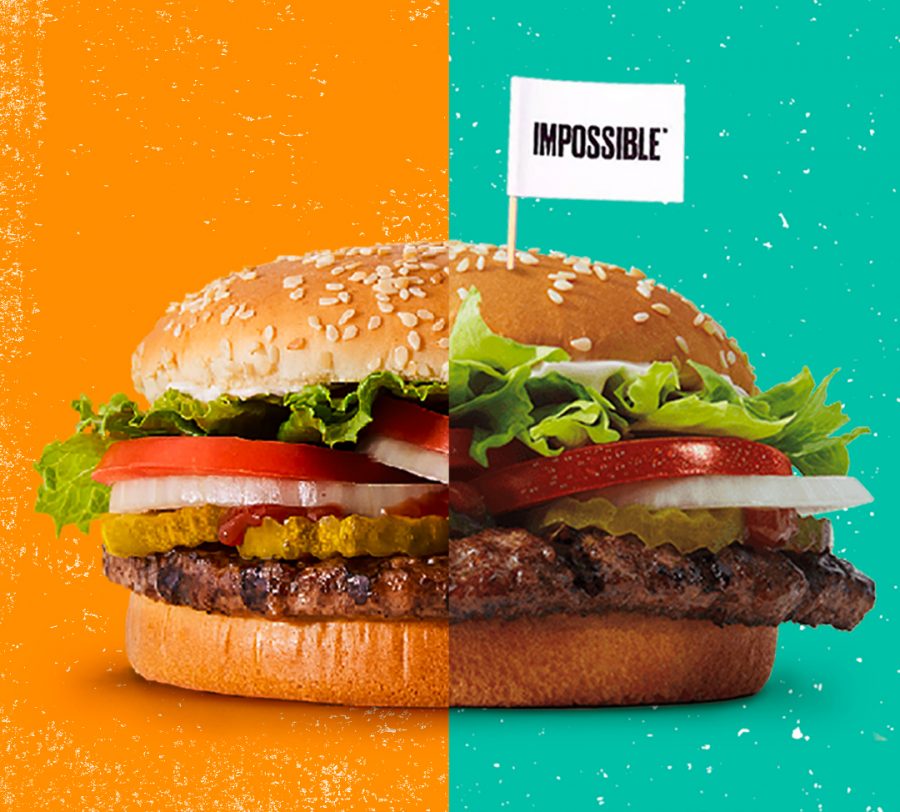Animal vs. man-made, mimic meat explained
The impossible burger is a hit—but to who?
Courtesy of Burger King’s Twitter
Burger King’s original Whopper burger (left) compared to the Impossible Whopper (right).
February 26, 2020
At 9 a.m, customers shuffle in aimlessly for their goto Burger King breakfast combo, located on Pulaski Highway. Cashier Angel Eastwood said approximately 30 plant-based burgers will be sold within her nine-hour shift.
U.S. retail sales of plant-based foods have increased 11 percent from 2018 to 2019 and have hit a plant-based market value of $4.5 billion.
“A lot of people just wanted to try it and see what it tasted like but some of them, once you tell them it’s a plant-based burger, they’re like, nevermind,” Eastwood said.
Impossible meat, curated from a soy protein concentrate, is among the several plant-based products that have popularized across the country. However, meat-like alternatives aren’t a new phenomenon.
With 30 years of Burger King experience, Eastwood recalled the chain’s attempt to sell a veggie burger, which was a MorningStar Farms Garden Veggie Patty brand.
At 330 calories, Burger King launched its veggie burger in 2002. However, as the Impossible Whopper popularized after it’s August launch and at twice the calories, the chain’s original meatless option was discontinued.
MorningStar, a series of frozen meatless products hit the shelves of grocery stores in 1975 and BOCA, a similar company, shortly followed with a mixable powder. The company transitioned to frozen products in the early 90s.
“It tasted better than anything on the market prior and it tasted like the real thing,” Mark Rifkin, a Baltimore-based registered dietitian said. “I know people that were eating that five days a week.”
Many meat mimicked products vary in ingredients. However, several remain constant including synthetic preservatives to prevent discoloration, red artificial food color to imitate the sensation of meat and magnesium carbonate to retain color.
Iron phosphate, which many have claimed to irritate the skin and stomach, as well as propylene glycol, an ingredient found in antifreeze and e-cigarettes, are commonly used ingredients.
For Maryland native Paige Parker, a North Carolina A&T psychology major, severe abdominal pain and vomit were the result of taste-testing the newest craze.
Parker said she was intrigued by her school’s rendition of the impossible burger and believed it was a more health-conscious decision.
Parker tested the sandwich twice. Her first experience caused her stomach pain, but she thought her symptoms stemmed from a previous meal. Parker hurled after her second attempt.
“I was happy that I had something that tasted like a burger but wasn’t actually a burger and it felt normal,” she said.
Parker realized that her symptoms had a direct correlation to the mimic meat, so she began to research its ingredients and was shocked by what she found.
“They have soy and all these other extremely processed because they try to make them taste like meat, so it doesn’t surprise me that they threw horrible ingredients in there,” Parker said.
Rifkin, who’s been a dietitian for 15 years and vegan for 35 years said fake meat is not marketed towards the health-conscious consumer, but rather the curious omnivore.
“They’re not going to duplicate the nutritional qualities of a black bean burger,” Rifkin said. “So people looking for these burgers to be healthy, to be some sort of nutritional paragon of virtue are going to be sorely disappointed.”
However, others such as plant-based dietitian Jennifer Mimkha, believe that factorized “meat” is geared towards a range of audiences including health-conscious consumers, environmental advocates and ethical vegans who may not be concerned with its controversial reviews.
“If it stops somebody from causing more environmental damage, causing more harm to animals, unnecessary suffering and increasing their health a little bit—then hey, I’m all for it,” Mimkha said.
Rifkin said the comparison between the impossible burger and the traditional Burger King Whopper is equivalent to the comparison of beer and vodka, one is healthier—but not by much.
“Beer is healthier than vodka, you should drink more beer—clearly that’s in the benefits,” Rifkin said. “No, that’s not a good recommendation but beer is healthier than vodka—you’re less likely to die.”
The competing patties are similar in nutritional value including a high percentage of fat, sodium and protein. However, man-made meat is free of cholesterol, E. coli and other cancerous agents traditionally linked to animal products.
As trends come and go, Rifkin said he’s witnessed the culture of veganism morphe into a dietary fad, which he attributes to celebrity influence.
“I learned that there’s a lot of ways to twist the research that supports vegan diets and if not everybody who goes into this lifestyle, understands the nuances of nutrition science or even vegan nutrition,” Rifkin said.
Several companies have added mimic meat to their menu, but the urge to stay on trend has caused food chains such as Burger King to go underwater.
Burger King customer Phillip Williams, the plaintiff in a $5 million class-action lawsuit, sued the American chain last year after. He claimed that he wouldn’t have bought the meatless option if he was aware it would undergo cross-contamination.
Burger King cooks these vegan patties on the same grills as its traditional meat products, thus covering the outside of the Impossible Whopper’s meat-free patties with meat by-product, according to the lawsuit.
Although Eastwood was unaware of the Florida-based lawsuit, she said Burger King gives its customers a microwavable option.
“I think we have to be mindful of everybody’s individual choices…it is one of the many benefits of living in a world of capitalism,” Mimkha said. “Consumer demand will dictate the supply and people are voting with their dollars.”












Brian • Feb 28, 2020 at 1:13 pm
*Credibility
Brian • Feb 28, 2020 at 1:13 pm
Great Story
Very detailed…
I liked the quotes and experiences from the people interviewed. It gave life (and creditability) to the story.
Well Done!!